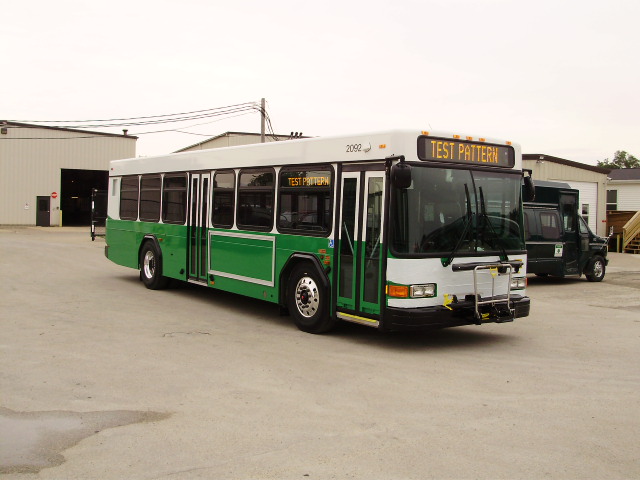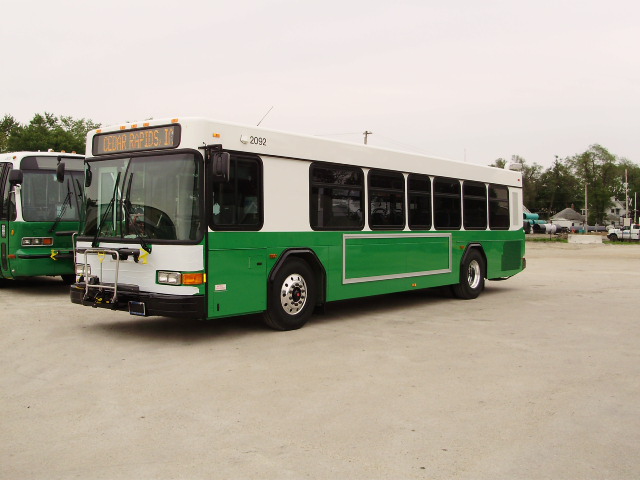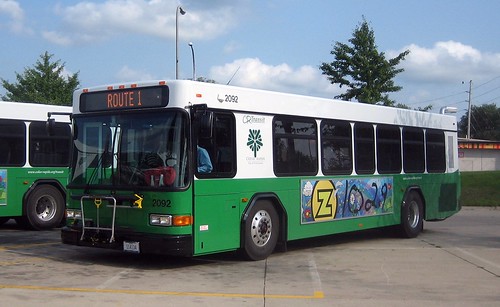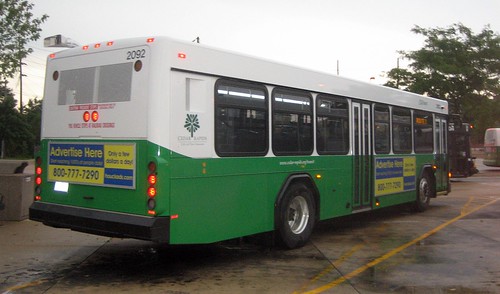The Corridor MPO has posted an online survey to provide initial feedback for the CR Transit study currently underway by SRF Consulting Group and Bourne Transit Consulting. If you are interested in seeing transit improvements in the Cedar Rapids area, please take a moment to take the survey.
Category: Transit (page 2 of 4)
This afternoon I attended an Impact CR meeting with Joseph Kern of SRF Consulting Group, one of the transit consultants hired by the Corridor MPO to study route and schedule improvements for CR Transit. SRF and Bourne Transit Consulting have teamed up to do the study that is to be completed in November.
Today’s meeting, with about 10-15 in attendance, was for the consultant and planning staff to get an impression of what the young professional demographic hopes to see improved with the system. Pretty much all my ideas and concerns were raised during the meeting. It seemed to come down to a balance between routes serving greater area (heavy focus of the current routes) versus more direct routes that result in quicker service. Also, pretty much everyone agreed on prioritizing improvements that would help dependent over features to attract new choice riders. However, I hope we do not settle too easily for a dependent-majority ridership. More choice riders means more riders overall, and therefor potentially better service for everyone. I am not transit-dependent, but I’d like to be able to take transit for a variety of trips in town without sacrificing a lot of time or convenience. It should be noted that I was one of only two people there who regularly take the bus here.
It sounds like the proposed routing changes will be relatively minor, but a good first step as CR slowly becomes more transit friendly. As Joseph Kern commented, if you can focus on improving service and amenities along a few specific, busy corridors, then that can help build more support and demand for further system changes. But of course, every system and city is a little bit different. Providing clear and ample information and marketing is certainly an important part of those changes.
For a few weeks now I’ve been working on my own CR Transit overhaul proposals – mostly for fun. My approach was more to start completely from scratch, but I soon realized that most of the current routes probably do work pretty well, it’s just a matter of adjusting them to interact better. After today’s meeting I have decided not to continue this effort as there really is no point to, and I’ve struggled to finish the remaining routes – particularly on the west side of town and in Marion. This route proposal was never intended to be scientific or taken literally, but more to represent bigger concepts to improve the system. Concepts such as adding transfer points besides downtown, implementing some crosstown routes, and increasing service frequencies on more heavily-used corridors, such as First Avenue between downtown and Lindale. Generally these ideas were all represented in today’s meeting so I’m sure some additional transfer points and better route syncing will be in the consultant’s final recommendations.
It’s clear any route and service improvements in the near future are not going to be drastic. Something that can be done more immediately, I believe, is better information and marketing. Availability and clarity of information was an expressed concern by many today. County Supervisor Ben Rogers claimed if his car broke down someday, he wouldn’t know how to get to work and back on the bus. I’m sure he could figure it out, but it’s no exaggeration that transit information is provided very minimally and poorly. Better marketing (knowledge of the system and service it provides) and a variety of information tools would benefit both dependent and choice riders.
You can view my incomplete CR Transit route proposal here. Note new transfer hubs at: downtown intermodal facility, Lindale Mall, Westdale Mall, corner of Edgewood and Blairs Ferry, and at Boyson Road and C Ave NE. I still intend to finish writing an extensive post about specific concepts and information tools I think could be implemented to provide better service for dependent riders and attract new choice riders as well. This will come sometime next week, as I’m going to DC tomorrow for a week, where I’ll be getting around predominantly by transit.
Two of CR Transit’s four new 35 ft. Gillig Lowfloor buses began their service life today on routes 1 and 2, in units 2092 and 2093, respectively. They were all supposed to be ready to go by today, but in the words of my afternoon bus driver, “you know how these things go…” These are the first brand new buses for Cedar Rapids in 15 years or so. Today is a good day for the future of CR Transit. Additional Gillig buses will be purchased over the next few years to further modernize the fleet.
Additional CR Transit bus photos on Flickr.
I started a summer job last week, only a little late in the season, at the Facilities office at Kirkwood Community College in SW Cedar Rapids. Living on the opposite side of town, I elected to ride to bus to and from work, through a combination of choice and necessity. I never had my own car in high school and have, so far not found the need, desire, or financial surplus to purchase my own during the past four years of college. I have also become quite an advocate of public transit over the past few years, and admittedly a little bit anti-car.
Living on the northeast side of town, my commute requires transferring routes downtown at the long-term temporary transfer site, Lot 44, at 12th Ave and 2nd Street SE. Before last year’s flood that claimed eight transit buses and extensive damage to the city bus garage, route departure times were at consistent intervals, and service headways were pretty much the same for every route. Generally all routes had half hour service during the moring and late afternoons, with hourly service during the midday and Saturdays. The only anomaly was the Route5’s (5N, 5S, 5B) which all run along 1st Avenue to Lindale Mall, then diverging along three different routes – serving north Marion, south Marion, and Hiawatha respectively. A 5 bus would depart downtown ever 30 minutes, but each individual route (5N, 5S, or 5B) would actually only leave every hour and a half.
When transit service resumed after the flood, there was limited service – I believe all routes started with hourly service during the day – I imagine due to a combination of lost busses, new flood-related expense circumstances, as well as assumed temporary decreased demand. Since then some routes have increased service to 30 minute headways in the morning and afternoon, but not all routes, including Route 3, the one that I can conveniently catch right behind my house in NE Cedar Rapids and ride downtown in about fifteen minutes.
The way the bus routes are laid out in a “spoke and wheel” fashion, makes it generally easy and convenient to commute to and from downtown if you’re near a route, but mobility between different areas of town – especially if they are on the same side (east or west) of the river/downtown – is much more difficult. Every single route originates in downtown and extends outward, like spokes in a wheel. Some routes occasionally cross each other but there is no systematic coordination for transfers between any routes outside of downtown. It is probably possible in some cases (I haven’t studied the schedules close enough), but it would be up to the passenger to investigate ahead of time on their own.
In my case, I’m traveling from the NE side of town to the SW, so transferring routes in downtown is convenient and efficient. But I still have problems with differing service frequency among routes and the fact that it takes me 50 minutes to ride to work. My “home” bus stop is along Route 3 at Lindale Ave and Tiffany Drive NE. Route 3 continues to operate “hourly” (70 minutes in the afternoon) all day, since service reductions after the flood. To get to Kirkwood I take Route 7 from downtown. 7 has resumed half-hour “peak” service in the morning and afternoon. My general working hours are pretty standard, 8am – 5pm with an hour break for lunch. The times hourly Route 3 meets up with half-hourly Route 7 to transfer do not work very well with my given schedule.
At Lindale Ave |
Arrive Lot 44 |
Depart Lot 44 |
Arrive Kwood |
|---|---|---|---|
| 6:25am | 6:40am | 6:50am | 7:15a |
| – – – | – – – | 7:20am | 7:45a |
| 7:25am | 7:40am | 7:50am | 8:15a |
| – – – | – – – | 8:20am | 8:45a |
| 8:25am | 8:40am | 8:50am | 9:15am |
Depart Kwood |
Arrive Lot 44 |
Depart Lot 44 |
At Lindale Ave |
| 4:15pm | 4:40pm | – – – | – – – |
| 4:50pm | 5:18pm | 5:30pm | 5:45pm |
| 5:15pm | 5:40pm | – – – | – – – |
| 6:00pm | 6:28pm | 6:40pm | 6:53pm |
As you can see I am pretty limited to certain times I can go to work and what times I can leave. Fortunately my workplace is pretty flexible so I just come in early at 7:15 (taking the 6:25 number 3 bus), but I still must stay there longer than an eight hour day in order to take the 4:50 Route 7 bus in the afternoon that will connect me to Route 3 in a timely fashion. Additionally, taking 50 minutes to travel a mere 10 miles or so is also not very convenient for me. In the current route structure, many routes loop around and a number of different streets in effort to cover the most physical area in a single route. This makes getting to your actual destination very time consuming and extremely inefficient. Bus routes that serve major destinations such as Kirkwood or large employers like Aegon and Rockwell Collins need to have more direct routes.
I’ve come up with four main criteria to evaluate the CR transit system:
1. Can I get to my destination on the bus routes?
2. Can I do so at a time that works with my schedule?
3. Can I travel by bus in a timely manner?
4. Is the bus comfortable and attractive?
In my case, the answer to criteria one would be yes. I can catch the bus right behind my house and get off the bus right by the building I work in at Kirkwood. For criteria two, the answer would be “sort of” – it is possible to get to and from work reasonably within my required timeframe, but there is certainly no flexibility. Three, can I travel in a timely manner? Absolutely not. A more direct route from downtown, or wherever routes connect, to Kirkwood could decrease my travel time. And, finally criteria four – the current bus fleet of majority older buses does not make for the most pleasant ride, but even more so, gives the system a less than stellar public image.
Fortunately all these issues may start to improve. The fourth issue should be the most visible improvement to come. Four brand new buses have arrived this month and should go into service within a few weeks. Additional new buses will be purchased over the next few years to replace older vehicles.
Regarding the first three issues, the Corridor Metro Planning Organization has issued a request for proposal to consultants for a fixed-route system analysis and recommendations for system improvements including changes to routes and schedule. According to the RFP, “The proposed routing options should focus on reducing travel times, increase the service area and increase the transit ridership. The analysis should include specific routing options, service schedules, expected ridership and driver scheduling.” A consultant is to be selected by July 17, and work is expected to be completed by mid November. The study, partially prompted by criticism of the system during the Neighborhood Planning Process earlier this year, will include three public open houses.
There are obviously many improvements – large and small – that could make CR Transit a much more effective system. In a future post I plan to further explore improvements and specific changes I believe will be necessary to bring Cedar Rapids’ transit system up to par. It is critical that Cedar Rapids becomes a more transit-friendly city.


The four brand new 35 foot, 2009 Gillig Lowfloor buses for CR Transit have arrived. They are not out in service just yet, but I was able to get a few preliminary photos of the new buses from fellow transit enthusiast James Roach. In these photos, a few details remain to be added (like the CR Transit lettering, 5 season tree logo, etc). Also the front of the bus below the windshield is green like the sides, it’s just still covered up with wrapping in the photos.
The exterior color scheme follows a new “CR Transit” branding that’s already in place on the eight used TMC RTS buses purchased earlier this year for flood replacement. The system officially dropped it’s former “EAGL” moniker and became known as CR Transit / Cedar Rapids Transit over a year ago. The existing older buses – old RTS’s and the Thomas Dennis SLF lowfloors – were not repainted but “EAGL” has been removed and replaced with the stylized “CR Transit” lettering.
This arrival is a pretty big deal, being the first brand new buses Cedar Rapids has seen in 10-15 years. Bill Hoekstra, head of the former combined transit and parking department, was an advocate of purchasing refurbished used buses instead of buying new. This saved the city some money but has done little for the bus system’s image. CR Transit will be purchasing additional Gilligs over the next few years to finally modernize the fleet. The new buses, units 2091-2094 (2 is the city dept. code, and 09 refers to year of manufacture). They should be in service within the next couple of weeks.
Check back frequently for new photo updates and other CR Transit news.
KCRG ran a story yesterday about possible route and service changes coming to Cedar Rapids Transit to make the system more convenient and efficient for citizens to use. Prompted by feedback from the Neighborhood Planning Process, the Corridor Metropolitan Planning Organization intends to study alternative route structures this summer, such as using Lindale and Westdale malls as hubs. The current “spoke and wheel” system, in which all routes originate from downtown, only works well if you are heading to or away from downtown. Another issue is frequency of service and limited hours of operation.
> KCRG: CR Bus System Could Get Overhaul
* UPDATE (6/23) *
The Corridor MPO has put out an RFP for a fixed route analysis of the Cedar Rapids Transit system. A consulting firm is to be selected by July 17, with the study completed by November of this year. The selected firm is expected to hold three open houses for the public and interested parties to provide input.
CR Transit maintains its presence at Lot 44 at 12th Ave SE and 2nd Street SE, for transfers and now dispatch. Trailers have been set up to provide an indoor waiting area with vending, public restrooms, and office for dispatchers.
Eight used 1992 TMC RTS buses were acquired in December and put in to service earlier this year – replacing buses lost in the flood. These buses debut the new green livery design and CR Transit branding. Older buses have not changed except the “CR Transit” lettering has been added to some of the newer Thomas Dennis SLF’s (but not all of them…?).
A few of the new RTS’s had bike racks installed, which was a previous plan to add bike racks to most of the bus fleet.
Four brand new 35 foot Gillig Lowfloor buses are due to arrive in April, an order unrelated to the floods. Additionally, CR Transit will be getting four new large buses and one medium duty bus with funding from the economic stimulus package.
See all new photos on Flickr.
CyRide has now published online the timetables for Moonlight Express Alpha (A) Shuttle. Previously the protocol for the late night weekend bus service, would be to call in to base for location and time of the fixed routes A – D. However, not everyone needing the bus on Friday and Saturday nights are drunk and are able to look up the bus schedule themselves. The schedule is only published until about 2am, even though service runs closer to 3am – this allows CyRide to adjust the schedule and service level as needed.
Timetables for Bravo (B) and Delta (D) shuttles, both serving Frederiksen Court, and Charlie (C Shuttle), serving Towers and Billy Sunday, remain unavailable to the public. Bravo and Delta alternate service to Frederiksen, providing continual 18 minute headways between Freddy and Campustown throughout the night. First campus-bound bus departs Freddy at 10:34pm, and then every 18 minutes after until end of service.
The February issue of CyRide’s Signals newsletter includes a list of what they have requested with anticipated transit funding in the national economic stimulus package. A specific wish list has been determined early so once funds are allocated, CyRide will have a chance to get orders in ahead of larger transit agencies, with arrival times for new bus orders typically around 18 months. Included are:
> 10 – 40-foot Heavy-duty Diesel OR Hybrid Electric expansion buses
> 3 – MD Low-floor buses (Full funding to upgrade minibuses 949, 960,961 to MD low-floor buses)
> 3 – MD low-floor bus upgrade (Add funding for 859, 938,939 at MD status as opposed to LD)
> 13 – 40-foot Heavy-duty replacement buses (926, 927, 933, 934, 941, 942, 943, 967, 980, 981, 983, 985, 990)
It is a priority of CyRide to upgrade its fleet and keep up with increasing service demand. However, the garage is basically at capacity and the roof is too low to fit hybrid buses, except for a few newer lanes, part of more recent additions. With no more room to expand on site, a satellite garage is rumored to be CyRide’s next step in facility expansion. It will be interesting to see what happens if all or even part of CyRide’s capital requests are approved and they have addition buses arriving in the next two years.
Additionally, the Ames City Council approved $93,000 from local option sales tax revenue, for city-wide fare free service this summer. The vote passed 4-2, with council members Riad Mahayni and Jami Larson voting no. Mahayni, a former CRP professor of mine, was concerned with the fairness to ISU students who regularly ride for free, but pay for it through student fees. Larson wondered about the consequences of offering a one-time fare free period and the implications when the free service ends in the fall.
Ultimately I think the initiative will get some additional residents on the bus and maybe persuade a few to continue when fares resume. I had not considered the fairness to students issue before, but the opportunity to increase long term ridership and community support is probably worth it. For the summer, CyRide will be unique among Iowa public transit agencies in providing fare free service to all, excluding Cambus which is operated by the University of Iowa and does not extend service beyond campus.
The decision was made this week to raise transit fares in Cedar Rapids to help make up for the city budget shortfall caused by the summer flood and current economic situation. The Gazette’s Rick Smith reported on his city government blog that regular fares will rise to $1.25 from $1, and reduced fare will increase from 50 cents to 60 cents. There was a proposal to eliminate Saturday service, which averages only 1300 riders each weekend, but the City Council rejected that proposal. Fares provide only about 15 percent of the transit operating costs.
© 2022 URBAN THINKING
Theme by Anders Noren — Up ↑



